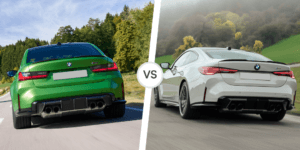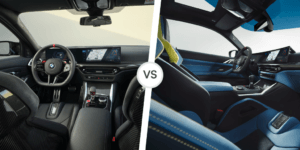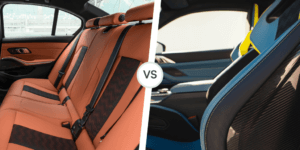What are the key differences between the BMW M3 and M4?
To start, let’s identify the fundamental differences between the BMW M3 and BMW M4.
The M3 is typically a four-door saloon, making it a preferred choice for those needing more practicality and passenger space without compromising on performance.
Meanwhile, the M4 is a sleek two-door coupe, designed for those who value style and sporty aesthetics. Both models share similar engines, yet their body styles and handling dynamics cater to slightly different audiences.

Left BMW M3, Right BMW M4
What are the size differences between the BMW M3 and M4?
Size can be a significant factor when deciding between these two models. Messing 4.79 metres, the M3’s four-door configuration provides easier access to the back seats, making it more family friendly or convenient for frequently carrying passengers.
The M4, however, offers a more compact and sporty feel with its two-door design, measuring around 4.67 metres. Despite these differences, both models offer ample boot space for their class.
BMW M3 dimensions:
- Length: 4794 mm
- Width (including mirrors): 2078 mm
- Height: 1433 mm
BMW M4 dimensions:
- Length: 4671 mm
- Width (including mirrors): 2027 mm
- Height: 1383 mm
Which BMW offers better value for money, M3 or M4?
In price, both models sit at the higher end of the used car market, reflecting their performance capabilities and luxury features.
The M3 presents a slightly higher starting price because of its additional doors and practicality, making it a superb choice if you need a balance of performance and everyday usability.
The M4, as a dedicated sports coupe, has a similar price, but may lack some of the practical features favoured by families, while offering more excitement for driving enthusiasts.
BMW M3 (used 2022):
- Starting Price: £39,000
- Typical Range: £39,000 – £55,000 (depending on trim and mileage)
BMW M4 (used 2022):
- Starting Price: £38,000
- Typical Range: £38,000 – £54,000 (based on trim and engine choice)

Left BMW M3, Right BMW M4
What are the performance and engine options available?
Under the bonnet, these models boast impressive powertrains. With rear-wheel and all-wheel drive options, the M3 accommodates different driving preferences and weather situations, enhancing its adaptability.
The M4 predominantly features rear-wheel drive, appealing to purists who love a traditional sports car feel. Both cars house the same turbocharged inline-six engine, providing exhilarating acceleration and top-notch performance.
The Jaguar E-Pace offers various engine choices, mainly focused on a balance of performance and efficiency:
Petrol Engines:
- P200: A 2.0-litre turbocharged four-cylinder engine, offering around 30-34 MPG. Known for its brisk acceleration and suitable for everyday driving.
- P250: A more robust 2.0-litre turbocharged engine providing similar MPG figures, but with enhanced power for more spirited driving.
Diesel Engines
- D150: A 2.0-litre diesel engine delivering approximately 45-49 MPG, ideal for those prioritising fuel economy on longer journeys.
- D180: Slightly more powerful, with similar efficiency, offering a balance between power and fuel savings.
Hybrid Option
- P300e: This plug-in hybrid combines a 1.5-litre three-cylinder petrol engine with an electric motor, achieving impressive efficiency figures over 140 MPG in electric mode, making it a standout for eco-conscious drivers.
Jaguar F-Pace Engine Options and MPG
Petrol Engines:
- P250: A 2.0-litre turbocharged engine, similar to the E-Pace, with MPG figures around 28-31.
- P400: A 3.0-litre inline-six mild hybrid engine, offering a smooth power delivery with approximately 24-27 MPG.
Diesel Engines:
- D165: A 2.0-litre diesel engine providing about 45-47 MPG, perfect for efficient long-distance cruising.
- D300: A more powerful 3.0-litre engine, offering 33-36 MPG, for those who need a bit more punch on the road.
High-Performance Petrol:
- SVR (5.0-litre V8): A supercharged engine that delivers performance, but lowers fuel efficiency to around 18-22 MPG.
Hybrid Option:
- P400e: Similar to the E-Pace’s hybrid, this option in the F-Pace offers a balance of power and efficiency, with MPG figures exceeding 130 in electric mode.
Which offers better interior and tech features?
BMW’s signature blend of luxury and modern technology greets you when you step inside either model. The M3, being slightly larger, often has an edge in cabin space, making it more comfortable for taller passengers.
Both models come equipped with premium materials and advanced tech features, such as digital displays, high-quality infotainment systems, and driver assistance technologies. If you value extra room and comfort, the M3 might suit you better, while the M4 provides a more intimate, driver-focused cockpit.

Left BMW M3, Right BMW M4
How do the BMW M3 and M4 stack up in terms of practicality?
Practicality is where the M3 excels. Its four-door design and generous boot make it a top pick for those who need their sports car to double as a family vehicle or a daily driver with more storage.
The M4, while still offering reasonable boot space, is more suited to those who prioritise style and performance over practicality. It’s perfect for weekend getaways or spirited drives but might fall short for routine family duties.
BMW M3 Boot Capacity:
- Boot Capacity: 480 litres
BMW M4 Boot Capacity:
- Boot Capacity: 440 litres

Left BMW M3, Right BMW M4
Which provides a better driving experience, the M3 or the M4?
Driving experience is subjective, but both the M3 and M4 deliver exhilarating rides typical of BMW’s M series. The M3, with its heavier build and all-wheel-drive option, provides a more stable and controlled drive, particularly in adverse weather.
Conversely, the M4, being lighter and more agile, offers a thrilling sports car experience with its precise steering and dynamic handling. If you cherish a spirited drive on twisty roads, the M4 might be your best bet.
How safe are the BMW M3 and M4?
Both vehicles deliver peace of mind, ensuring safety remains uncompromised alongside performance
BMW M3 Safety Features
- Adaptive cruise control
- Lane departure warning
- EURO NCAP Rating: 5 stars
BMW M4 Safety Features
- Automatic emergency braking
- Blind spot monitoring
- EURO NCAP Rating: 5 stars
Verdict on BMW M3 vs M4
In conclusion, choosing between the BMW M3 and M4 largely depends on your preference and lifestyle needs. The M3 shines with its practicality and all-weather capability, making it ideal for those who require a performance vehicle that suits family life.
The BMW M4, however, offers a pure sports car experience, best suited for those who value style and dynamic driving.
Whichever model you choose, both the M3 and M4 deliver the performance and luxury that BMW is renowned for. To explore more about these models and others in the BMW lineup, visit MOTORS for detailed listings and more information.


